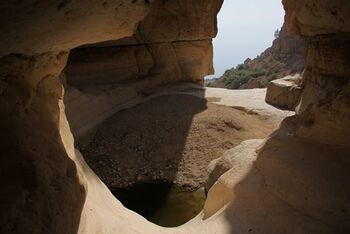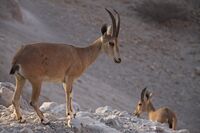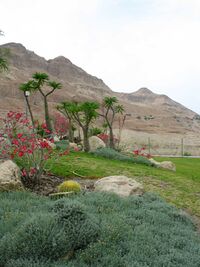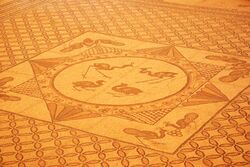عين جدي
31°27′0″N 35°23′0″E / 31.45000°N 35.38333°E

عين جدي (بالعبرية: עֵין גֶּדִי), literally "spring of the kid (young goat)"[1] هي واحة و محمية طبيعية في إسرائيل ، وتقع غرب البحر الميت، بالقرب من مسادا وكهوف قمران. تم إدراج عين جدي في عام 2016 كأحد المواقع الطبيعية الأكثر شعبية في البلاد.[2] يجذب الموقع حوالي مليون زائر سنويًا.[3]
علم أصل الكلمة
يتكون اسم Ein Gedi من كلمتين العبرية: كلمة "ein" تعني الربيع و "gǝdi" تعني طفل الماعز. وبالتالي فإن عين جدي تعني "ينبوع الطفل" أو "ينبوع الطفل".
التاريخ وعلم الآثار
العصر الحجري الحديث
عثر علماء الآثار في كهف ميكفيه على أدوات صوان ما قبل الفخار من العصر الحجري الحديث (PPNA) ورأس سهم.[بحاجة لمصدر]
العصر الحجري النحاسي
تم حفر معبد نحاسي (حوالي منتصف الألفية الرابعة قبل الميلاد) ينتمي إلى الثقافة الغسولية على المنحدر بين نبعين ، عين شولاميت وعين جدي. تم إجراء المزيد من الاكتشافات النحاسية في كهوف المورينجا وميكفيه.[4]
العصر البرونزي
لم يتم العثور على آثار لمستوطنة العصر البرونزي في عين جدي.[بحاجة لمصدر]
العصر الحديدي
The remains of the Iron Age settlement at Ein Gedi are located at a tell on the north bank of Wadi Arugot, known in Arabic as Tell el-Jurn and in Hebrew as Tel Goren. The first permanent Iron Age settlement was Judean and was established around 630 BCE. The site was destroyed or abandoned after the Babylonian destruction of Jerusalem in 587/86 BCE.[بحاجة لمصدر]
الكتاب المقدس العبري
In Joshua 15:62, Ein Gedi is enumerated among the wilderness cities of the Tribe of Judah in the desert of Betharaba, and in Ezekiel 47:10, it is prophesied that one day, its coastal location will make it into a fishing village, after the water of the Dead Sea has been made sweet:
- Fishing nets will be spread from En-gedi to En-eglaim.[5]
Fleeing from King Saul, David hides in the strongholds at Ein Gedi (1 Samuel 23:29 and 24:1-2) and Saul seeks him "even upon the most craggy rocks, which are accessible only to wild goats" (1 Samuel 24:2). Psalm 63, subtitled a Psalm of David when he was in the wilderness of Judah, has been associated with David's sojourn in the desert of En-gedi.[6]
In 2 Chronicles 20:2 Ein Gedi is identified with Hazazon-tamar,[7] Hazezon Tamar,[8] Hatzatzon-Tamar [9] or Hazezontamar (חַצְצוֹן תָּמָר ḥaṣṣōn tāmār, "portion [of land] of date palms"), on account of the palm groves which surrounded it,[10] where the Moabites and Ammonites gathered in order to fight Josaphat, king of Judah. In Genesis 14:7 Hazazon-tamar is mentioned as being an Amorite city, smitten by Chedorlaomer in his war against the cities of the plain.
The Song of Songs (of Solomon%201:14&verse=HE&src=! Song of Solomon 1:14 HE) speaks of the "vineyards of En Gedi". The words of Ecclesiasticus 24:18, "I was exalted like a palm tree in Cades" (’en aígialoîs), may perhaps be understood as the palm trees of Ein Gedi.
الفترة الفارسية
The settlement at Tel Goren is a rare example of a town which reached its zenith during the Persian period, probably during the late 5th century BCE.[بحاجة لمصدر]
الفترة الهلنستية
Ein Gedi receives a fortress and becomes a royal Hasmonean estate.[بحاجة لمصدر]
الفترة الهيرودية والرومانية
According to the Jewish-Roman historian Josephus Flavius, the Sicarii, who fought the Romans until their defeat and mass suicide at Masada, plundered local villages including En Gedi. At En Gedi, they drove out the defenders, and killed over seven hundred women and children who could not run away.[11][12][13]
الفترة البيزنطية
The indigenous Jewish town of Ein Gedi was an important source of balsam for the Greco-Roman world until its destruction by Byzantine emperor Justinian as part of his persecution of the Jews in his realm.[بحاجة لمصدر] A synagogue mosaic remains from Ein Gedi's heyday, including a Judeo-Aramaic inscription mosaic now on display at Jerusalem's Schottenstein campus museum warning inhabitants against "revealing the town's secret" – possibly the methods for extraction and preparation of the much-prized balsam resin, though not stated outright in the inscription – to the outside world.[14]
العصر العثماني
In 1838, Edward Robinson reported that the whole area were covered with gardens, mainly cucumbers, all belonging to the Rashaideh tribe.[15]
In April 1848, Lieutenant William Francis Lynch led an American expedition down the Jordan River into the Dead Sea, that stopped at En Gedi (Ain Jidy).[16]
إسرائيل
In 1998–99, the archaeological expedition of Yizhar Hirschfeld at Ein Gedi systematically excavated what has been called "the Essenes site", first discovered by Yohanan Aharoni in 1956.[17]
محمية طبيعية ومنتزه وطني

Ein Gedi nature reserve was declared in 1971[18] and is one of the most important reserves in Israel. The park is situated on the eastern border of the Judean Desert, on the Dead Sea coast, and covers an area of 14000 dunams (3,500 acres or 14 km2).[18]
The elevation of the land ranges from the level of the Dead Sea at 423 meters (1,388 ft) below sea level to the plateau of the Judean Desert at 200 meters above sea level. Ein Gedi nature reserve includes two spring-fed streams with flowing water year-round: Nahal David and Nahal Arugot (German article at: de:Nachal Arugot). Two other springs, the Shulamit and Ein Gedi springs, also flow in the reserve. Together, the springs generate approximately three million cubic meters of water per year. Much of the water is used for agriculture or is bottled for consumption.
The reserve is a sanctuary for many types of plant, bird and animal species. The vegetation includes plants and trees from the tropical, desert, Mediterranean, and steppian regions, such as Sodom apple, acacia, jujube, and poplar. The many species of resident birds are supplemented by over 200 additional species during the migration periods in the spring and fall. Mammal species include the Nubian ibex and the rock hyrax.
The Ein Gedi national park features several archaeological sites including the Chalcolithic Temple of Ein Gedi and a first-century CE village. The park was declared in 2002 and covers an area of 8 dunams (2.0 acres or 8,000 m2).[18]
كيبوتس

Kibbutz Ein Gedi, founded in 1956, is located about a kilometer from the oasis. It offers various tourist attractions and takes advantage of the local weather patterns and the abundance of natural water to cultivate out-of-season produce. The kibbutz area contains an internationally acclaimed botanical garden covering an area of 100 dunams (10 ha, 24.7 acres). There one can find more than 900 species of plants from all over the world. The kibbutz is also home to the Ein Gedi Eco Park, which functions as both a zoo and an environmental education center, demonstrating sustainable technologies such as solar cookers, greywater systems, mud buildings, and compost toilets.
ماراثون شالوم - البحر الميت نصف ماراثون
The Ein Gedi race, also known as the Shalom Marathon – Dead Sea Half Marathon is a popular road running event over several distances that has been held by the Tamar Regional Council since 1983. The starting point for all races is the Ein Gedi Spa, 80 kilometers (50 mi) southeast of Jerusalem and 4 kilometers south of Kibbutz Ein Gedi.[19][20]
انظر أيضاً
المصادر
- ^ Palmer, 1881, p. 416
- ^ Israel nature spots draw 2 million visitors, Haaretz
- ^ What Israel's nature reserves booking system reveals, Haaretz
- ^ Gošić Arama, Milena (2016). "Temples in the Ghassulian Culture: Terminology and social implications". Issues in Ethnology and Anthropology. 11 (3): 872–874. Retrieved 18 June 2019.
- ^ Jerusalem Bible: Ezekiel 47:10
- ^ Joseph Lightfoot, Works, vol. 1. p. 58, referenced by Gill, J. in Gill's Exposition of the Bible on 1 Samuel 23, accessed 24 May 2017
- ^ e.g. ASV, NRSV and CEB
- ^ e.g. NKJV
- ^ e.g. CJB
- ^ A Smaller Dictionary of The Bible, Sir William Smith, 1914, John Murrey, London. page 169.
- ^ The Wars of the Jews, or History of the Destruction of Jerusalem, by Flavius Josephus, translated by William Whiston, Project Gutenberg, Book IV, Chapter 7, Paragraph 2.
- ^ Flavius Josephus, De bello Judaico libri vii, B. Niese, Ed. J. BJ 4.7.2
- ^ Ancient battle divides Israel as Masada 'myth' unravels; Was the siege really so heroic, asks Patrick Cockburn in Jerusalem, The Independent, 30 March 1997
- ^ Bar, Aviva (2010-01-26). "Ein Gedi, A Streamlined approach". Jpost.com. Retrieved 2011-11-24.
- ^ Robinson and Smith, 1841, vol 2, p. 212
- ^ William Francis Lynch (1852). Narrative of the United States' expedition to the river Jordan and the Dead sea. Blanchard and Lea. pp. 282–296. Retrieved 10 November 2010.
- ^ Jesus and Archaeology, page 389, James H. Charlesworth, Wm. B. Eerdmans Publishing, Grand Rapids, Michigan 2006. ISBN 9780802848802
- ^ أ ب ت "List of National Parks and Nature Reserves" (PDF) (in العبرية). Israel Nature and Parks Authority. Archived from the original (PDF) on 2009-10-07. Retrieved 2010-09-27.
- ^ "Ein-Gedi Race" Archived فبراير 10, 2010 at the Wayback Machine
- ^ Yagna, Yanir (2008-04-02). "Runners collapse near Dead Sea as temperatures hit seasonal highs". Haaretz.com. Retrieved 2011-11-24.
Bibliography
- Conder, C.R; Kitchener, H.H. (1883). The Survey of Western Palestine: Memoirs of the Topography, Orography, Hydrography, and Archaeology. Vol. 3. London: Committee of the Palestine Exploration Fund. (pp. 384-386)
- Hirschfeld, Yizhar, ed. (2006). Ein Gedi. "A Very Large Village of Jews". Haifa: Muzeon Reuven ve-Idit Hekht. ISBN 9789657034064.
{{cite book}}:|work=ignored (help) - Robinson, E.; Smith, E. (1841). Biblical Researches in Palestine, Mount Sinai and Arabia Petraea: A Journal of Travels in the year 1838. Vol. 2. Boston: Crocker & Brewster.
- Robinson, E.; Smith, E. (1841). Biblical Researches in Palestine, Mount Sinai and Arabia Petraea: A Journal of Travels in the year 1838. Vol. 3. Boston: Crocker & Brewster. (Robinson and Smith, 1841, vol 3, Appendix 2, p. 116)
- Palmer, E.H. (1881). The Survey of Western Palestine: Arabic and English Name Lists Collected During the Survey by Lieutenants Conder and Kitchener, R. E. Transliterated and Explained by E.H. Palmer. Committee of the Palestine Exploration Fund.
- Warren, C. (1869). "Remarks on a visit to 'Ain Jidy and the southern shores of the Dead Sea in mid-summer 1867". Quarterly statement - Palestine Exploration Fund. 1: 143–150. (pp. 143-150)
وصلات خارجية
- Virtual Tour of Ein Gedi - View from the Ein Gedi Promenade
- Ein Gedi in the Dead Sea Map - Bird's-eye view in Flash
- The Israel Nature and Parks Authority - Site page
- Ein Gedi Travel Guide
- Pictures of Ein Gedi synagogue
- Ein Gedi mill, 1893
- Survey of Western Palestine, Map 22: IAA, Wikimedia commons
خطأ لوا في وحدة:Authority_control على السطر 278: attempt to call field '_showMessage' (a nil value).
- Pages using gadget WikiMiniAtlas
- CS1 العبرية-language sources (he)
- Coordinates on Wikidata
- Articles containing عبرية-language text
- Articles with unsourced statements from January 2017
- Articles with unsourced statements from January 2018
- Articles with hatnote templates targeting a nonexistent page
- CS1 errors: periodical ignored
- تلال (علم آثار)
- أماكن في الكتاب العبري
- حدائق وطنية في إسرائيل
- قرى فلسطين
- محميات طبيعية في إسرائيل
- مدن كنعانية
- مستعمرات يهودية قديمة في يهودا
- مناطق فلسطين
- ينابيع إسرائيل
- مناطق محمية في المنطقة الجنوبية (إسرائيل)
- حدائق نباتية في إسرائيل

